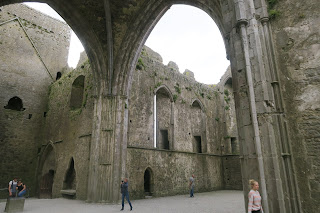According to local legends, the Rock of Cashel originated in the Devil’s Bit, a mountain 30kms north of Cashel when St. Patrick banished Satan from a cave, resulting in the Rock’s landing in Cashel. Cashel is reputed to be the site of the conversion of the King of Munster by St. Patrick in the 5th century. The word ‘cashel’ is an Anglicised version of the Irish word caiseal, meaning ‘fortress’. In the 4th century the Rock of Cashel was chosen as a base of the Eoghanachta clan from Wales, who went on to conquer much of Munster and become kings of the region. For some 400 years it rivalled Tara as a centre of power in Ireland. In the 10th century the Eoghanachta lost possession of the rock to the O’Brien tribe, and in 1101 King Muircheartach O’Brien presented the Rock to the Church to curry favour with the powerful bishops and to end secular rivalry over possession of the Rock with the Eoghanachta. This beautiful complex has a character of its own and it has one of the most remarkable collections of Celtic art and medieval architecture to be found anywhere in Europe. Few remnants of the very early structures survive, but even so the buildings here today date back to the 12th and 13th centuries.
The entire plateau on which the building and graveyard lie is walled. In the grounds around the buildings an extensive graveyard includes a number of high crosses. Scully’s Cross, one of the largest and most famous high crosses here, was originally constructed in 1867 - with the ringed top of the cross being sheared off by lightning in 1976.
Hore Abbey, as seen through the wall around the Rock of Cashel. It was founded in 1270 and was the last Cistercian foundation in Ireland.
Scully’s Cross
This is the door into the round tower - as you can see, well off the ground
Here you can see Cormac’s Chapel on the left, and the cathedral on the right
The Cathedral is truly incredible!! It was built between 1235 and 1270 and was used for worship until the mid-1700s. It is an aisleless building of cruciform plan - and is just magnificent!
Looking down onto the town of Cashel from The Rock
This is definitely a place where I was completely in awe - and hope to return again!


































No comments:
Post a Comment